Hyundai
Elantra Nu MPI 2.0L Engine Oil Change Guide
How to change the motor oil and filter on
the Nu MPI 2.0L I4 engine in a 6th generation 2017 to 2020 Hyundai Elantra.
By Paul B. Michaels Author & Photographer Auto Mechanic Since 1989 |
||
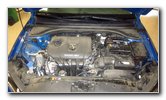 2018 Elantra Nu 2.0L I4 |
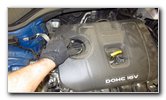 Loosen Oil Fill Cap |
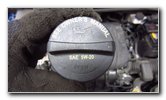 Oil Cap - SAE 5W-20 |
| This automotive
maintenance tutorial was specifically written to assist owners of the 6th
generation (2017, 2018, 2019, 2020 and most likely also the upcoming 2021 model
year) Hyundai Elantra sedan in changing the motor oil and replacing the oil
filter on the Nu MPI 2.0 liter Atkinson cycle inline four cylinder
engine. (The procedure should be very similar for the Kappa 1.4L
I4 engine and the Gamma 1.6L turbocharged I4 engine.) Owners of other Hyundai, Genesis or Kia vehicles such as the Sonata, Accent, Veloster, Ioniq, Kona, Nexo, Venue, Tucson, Santa Fe, Palisade, G70, G80, G90, Soul, Sportage, Niro, Sorento, Telluride, Rio, Forte, Optima, Stinger, Cadenza, K900, Sedona and Seltos may also find these DIY instructions to be helpful. A few compatible replacement oil filters with their part numbers are as follows: Mobil 1 M1-104, Wix 51334, Royal Purple 10-2808, Fram HM9688 and Purolator PL14459. The oil capacity specification for the Nu MPI 2.0L I4 engine for an oil change with a filter replacement is 4.23 U.S. quarts (or 4.0 liters). So you'll need to purchase five U.S. quarts of SAE 5W-20 oil which is the preferred viscosity for better fuel economy. (If you live in a very cold or extremely hot climate, check the owner's manual for the recommended oil type.) The tools and other items needed to complete this procedure include a floor jack, two jack stands, a used oil catch container, a 17mm socket with a 3/8" or 1/2" drive ratchet, a Lisle 63600 oil filter wrench (optional) and an automotive funnel. The first step is to warm up the engine for a few minutes to near operating temperature. Warming up the engine will help suspend any contaminants within the old oil and also allow it to drain out more quickly. Then drive the car on to a level surface, shift the transmission into "Park" and turn off the ignition. Engage the emergency / parking brake and place wheel chocks on both sides of the rear tires to help prevent the car from moving. Open the hood, twist off the oil filler cap in the counterclockwise direction and partially remove the oil dipstick an inch or two. Set the oil fill cap aside in a safe place. Removing the oil fill cap and lifting up the dipstick will help prevent a vacuum from forming and allow the old oil to drain out more quickly. |
||
|
|
||
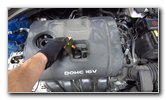 Partially Remove Dipstick |
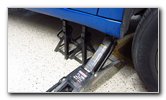 Raise Front of Vehicle |
 Plastic Under Engine Cover |
| Carefully raise the
front of the car with a floor jack and securely support it with at least two
jack stands. Please do not solely rely on the floor jack to support the vehicle! Alternatively, you could drive the car up on two automotive ramps. Slide under the front of the vehicle with a used oil catch basin, the 17mm socket and a 3/8" or 1/2" drive ratchet. Locate the pear shaped cutout in the black plastic under engine cover (or "skid plate") for the oil drain bolt access. Closer to the front of the vehicle is the circular cutout for accessing the oil filter. |
||
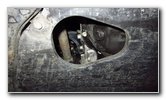 Drain Bolt Access Hole |
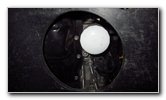 Oil Filter Access Opening |
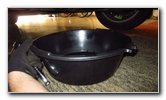 Used Oil Catch Basin |
| Some Elantra models
may have plastic access covers for the oil drain bolt and filter that need
to removed.
Slide the used oil catch container to just below the oil drain bolt. |
||
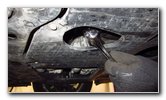 Loosen Counterclockwise |
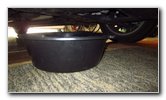 Drain Out Old Oil |
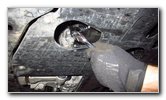 Replace Oil Drain Bolt |
| Loosen the oil
drain bolt in the counterclockwise direction with the 17mm socket and a 3/8"
or 1/2" drive ratchet. Be careful when you remove the drain bolt. The old oil might still be hot enough to burn your fingers depending on how long you warmed up the engine in the first step. Spin out the bolt the rest of the way by hand. Inspect the metal washer (or "gasket") on the oil drain bolt. If necessary, replace the washer with a new one. Some mechanics prefer to change the washer at every oil change while others re-use for several oil changes. The OEM part number for the drain plug washer is Hyundai 21513-23001. Allow the old oil to drain out for at least a few minutes or until the flow slows down to just an occasional drip. Clean the oil drain hole and the area around it with a paper towel. Make sure that the old washer is not still attached to the oil pan. Spin in the oil drain bolt a few turns by hand in the clockwise direction to prevent it from becoming cross threaded. Tighten the oil drain bolt with the 17mm socket and a ratchet by turning it in the clockwise direction until it is snug. If you have a torque wrench, the service manual specification for properly tightening the oil drain bolt is a range of 25.3 to 32.5 lb-ft of torque. |
||
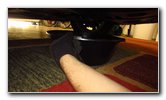 Slide Oil Basin Forward |
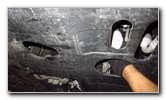 Twist Off Old Oil Filter |
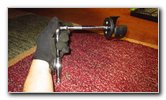 Lisle Oil Filter Wrench |
| Carefully slide the
used oil catch container forward to just below the old oil filter. Twist off the old oil filter by turning it in the counterclockwise direction. If you have trouble loosening the old oil filter due to it being over tightened at the dealership or a quick lube oil change shop, I highly recommend using the Lisle 63600 oil filter wrench. It makes loosening stubborn or stuck oil filters extremely easy. Attach the oil filter wrench to an extension bar and a 3/8" drive ratchet. |
||
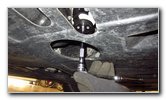 Loosen Counterclockwise |
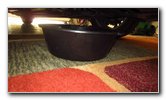 Drain Oil From Filter |
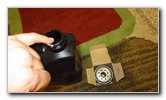 Dip Finger In New Oil |
| Loosen the old oil
filter by turning it in the counterclockwise direction with the filter
wrench. Then spin off the old filter the rest of the way by hand. Allow the old oil to drain out from the filter and the receptacle for at least a few minutes. Discard the old oil filter. Dip your pinky finger into some new oil. |
||
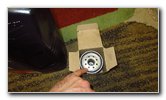 Lubricate Rubber O-Ring |
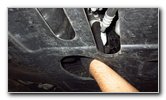 Twist On New Oil Filter |
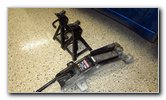 Lower Car From Stands |
| Lubricate the
rubber o-ring gasket on the new oil filter. Lubricating the o-ring will help it form a better seal, prevent oil leaks and also make the filter much easier to remove during the next oil change. Make sure that the rubber o-ring from the old oil filter is not still attached to the engine. Twist on the new oil filter in the clockwise direction to about 1/2 to 3/4 of a turn past finger tight. (The torque specification in the shop manual for the oil filter is a range of 8.7 to 11.6 lb-ft of torque.) Double check that the oil drain plug and the new oil filter are tight before moving on to the next steps. Carefully lower the car from the jack stands by using the floor jack. |
||
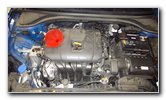 Insert Automotive Funnel |
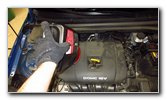 Slowly Pour In New Oil |
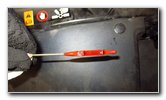 Check Dipstick Oil Level |
| Insert the
automotive funnel into the oil fill port. The owner's manual specification for the Nu MPI 2.0L I4 engine's oil capacity for an oil change with a filter replacement is 4.23 U.S. quarts (or 4.0 liters). The oil viscosity recommendation for most climates and to achieve the best possible fuel economy is SAE 5W-20. Since it is much better to have less oil than necessary in an engine than to run an engine that has been overfilled, I recommend at first only pouring in about 3.75 to 4 U.S. quarts. Running an engine that has been overfilled can result in sluggish performance or cause damage to seals, gaskets or other components. Slowly pour in the new oil. Then temporarily replace the oil filler cap by twisting it on in the clockwise direction and push down the oil dipstick's handle. Start the engine and allow it to warm up for a few minutes. Turn off the ignition and allow the new oil to drain back down to the oil pan for at least 5 to 10 minutes. Check the oil level on the dipstick by pulling it out, wiping it clean with a paper towel, fully re-inserting it and then pull it out again. If necessary, slowly pour in more oil up to the 4.23 U.S. quarts total capacity and repeatedly check the level on the dipstick until it reaches the upper line on the dipstick just below the "F" which indicates the "Full" or "Maximum" line. You may not need to pour in the entire 4.23 U.S. quarts of new oil in order to reach the "F" line depending on how long you allowed the old oil to drain out. Save the remaining 0.77 of a quart of oil for your next oil change. You'll only have to buy 4 quarts instead of 5. |
||
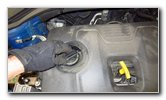 Tighten Oil Filler Cap |
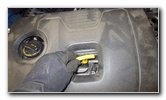 Push Down Oil Dipstick |
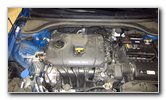 Oil Change Complete! |
| Once the oil level
is correct, tighten the oil fill cap in the clockwise direction until it is
snug and replace the dipstick. Be sure to write down the oil change in your car's service records. The service interval specification for changing the oil and filter in the owner's manual is every 7,500 miles (or 12,000 KM). It would also be a good idea to check your garage, driveway or parking spot for drops of fresh oil during the next few days since they might indicate a leak from the drain bolt or the new filter. For more, please check out all of my
2017-2020 Hyundai Elantra DIY Repair & Maintenance Guides. |
||
| If you found this guide to be helpful,
please consider making a small donation by clicking on the PayPal.com
"Donate" button located to the right of this paragraph. Thank you!
(Note: I am not a registered charity. Donations are not tax deductible.) |

